Chow Chow and Shar Pei
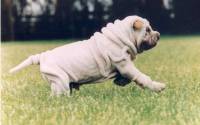 Shar Pei pup
Shar Pei pup
The common Chinese origin of the Chow Chow and Shar Pei is indisputable. But the Chow Chow has enjoyed a continuous development as a pure breed whereas the Shar Pei did not. Additionally the difference in coat suggests the Chow Chow originally probably developed in the cold North and Western parts of China with a connection with the Esquimaux Dog whereby the Shar Pei developed in the warmer southern regions. But they do make an interesting comparison!
History of the Chow Chow
 Grave Statue c 200 AD
Grave Statue c 200 AD
The now extinct prehistoric dog-like mammal the 'Simicyon', appears to have influenced Chinese breeds to have have broad skulls and wide mouths[7], as seen in the development of the Shih Tzu, Lhasa Apso and Tibetan Terrier and Asian Toy breeds. Perhaps this "Pei' dog influenced the transition of the early Esquimaux dog to produce dogs of Chow type in China which looked like the ancient Grave Statue pictured on the left. For centuries, the Chow Chow was:
 Chow Chows c 1907
Chow Chows c 1907
"... a good second to his master in the operation of capture. Ever distrustful of strangers, he is the faithful guardian of his village, wakeful and noisy at night, sleepy and persecuted during the day. He is brave in the defence of his home, keen of nose, and untiring in the chase, though sorely oppressed by the warmness of his heavy coat, necessary as a protection against the thorns and prickly creepers which tangle his native thickets. His powers of scent are used today in the capture of birds for the table, just as, in all probability, before the European bird-dog was invented"[1a]
Because the name 'Chow' in modern language is usually associated with food, there is a perception that this dog was primarily bred for human consumption. Although many centuries ago this may have occurred, it is more likely that the name Chow Chow originated from "pidgin" English which was the language of trade used in Chinese ports in the early 1700's to describe anything that was traded especially spices like ginger[1].
The Chow Chow becomes a Pure Breed
 Chow Chow puppy
Chow Chow puppy
By the late 1700's the Chow Chow had become known as an all-purpose type of dog commonly seen roaming not only around the streets of the cities, and also throughout the countryside. In 1790 the Chow Chow was first brought to England by the East India Trading Company. In 1802 White wrote the following description:
"... they are about the size of a moderate spaniel; of a pale yellow colour, with coarse bristling hairs on their backs; sharp upright ears and peaked heads, which give them a very fox like appearance. Their hind-legs are unusually straight, without any bend at the hock or ham, to such a degree as to give them an awkward gait when they trot. When they are in motion their tails are curved high over their backs like those of some hounds, and have a bare place on the outside from the tip midway, that does not seem to be matter of accident but somewhat singular. Their eyes are jet-black, small and piercing ; the insides of their lips and mouths of the same colour, and their tongue blue.... These dogs bark much, in a short, thick manner, like foxes, and have a surly, savage demeanour, like their ancestors... " [1a]
 Chow Chow c 1880
Chow Chow c 1880
In 1828 the London Zoo acquired some as a curiosity. Despite records of being exhibited at Birmingham and other Shows, it would be 1894 before the Kennel Club (UK) finally recognised them. From the earliest times the Chow came in both rough and smooth coats. Both coats displayed the characteristic 'Scowl' the first description of which was 'loose skin on the forehead accentuated by slight differences in pigmentation'.[2]
History of the Shar Pei
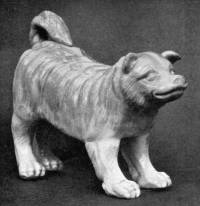 Shar Pei Grave Statue c 1700
Shar Pei Grave Statue c 1700
Statues of wrinkled dogs like the one pictured bearing a strong resemblance to the Shar Pei date back to the Han Dynasty (c 200 BC). Others have been discovered in Tai Li, a small village in the Southern Province of Kwantung, which borders the South China Sea. More recently a 13th Century Chinese manuscript refers to a wrinkled dog. The name 'Shar Pei' literally means 'sand skin', referring to the roughness and shortness of the coat[8].
The Shar Pei becomes a Pure Breed
The Shar Pei's survival as a pure breed today relied on Hong Kong becoming a British Colony in 1842. This was because by one century later, the Chinese Communist Party had eliminated dogs from most of China[6]. But fortunately, because in the meantime the Hong Kong and Kowloon Kennel Association had recognised the Shar Pei as a pure breed in the 1970's, they were able to provide bloodlines for the rest of the world to resurrect the breed[3]. They were introduced into Australia in the early 1980's[5a].
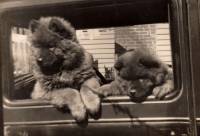 Chow Chow pups c 1930
Chow Chow pups c 1930
History of Chow Chows in Australia
Chow Chows were among our earliest exotic breeds to be imported into Australia with 5 arriving between 1907 and 1911 and another 7 listed in Tyzack's Stud Book[4]. Archival records of Melbourne Zoo also record that at least 7 'Chinese Dogs' were on display[5].
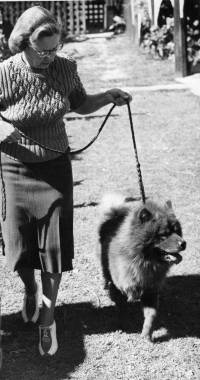 Ch Red Dragon of Macreag
Ch Red Dragon of Macreag
Before the outbreak of World War Two, another 12 Chows were recorded as being imported from UK[9]. This was remarkable considering the only way these dogs could travel was by sea which could take up to 3 months. Two separate newspaper clippings tell different stories of this long voyage. One reports a top winning dog breaking its chain and disappearing overboard, while another reports that two prized dogs
"... enjoyed a deluxe passage, receiving better service and attention than passengers in First Class! They were fed raw spinach and special food preparations throughout the voyage. In the tropics they were bathed three times a day and for most of the voyage. Their attendants, an elderly English couple, slept on the open deck to be near them. This couple jumped at the chance to migrate to Australia when two elderly Hurstville women offered them the job of caring for the two Chow Chow dogs they were importing"[10]
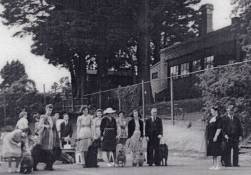 First Show at Helpmann's home 1940. Mrs Helpmann 2nd from right
First Show at Helpmann's home 1940. Mrs Helpmann 2nd from right
In 1934 the Chow Chow Club of Australia was formed. By 1940 this had became became the Chow Chow Club of Victoria, holding their first Open Parade at the home of Mrs J Helpmann, who became their first Patron. She was also the mother of the famous multi-talented, Sir Robert Helpmann. With such patronage, the fame of the Chow Chow spread to every State in Australia. For example by the 1940's, Queensland dog Ch Red Dragon of Macreag (pictured above left) had won at least 81 First Prizes and 33 Challenges.
Comparison between the Chow Chow and the Shar Pei
 Chow Chow
Chow Chow
The unique features of the Chow Chow are
- His 'scowling' expression
- His bluish-black tongue coupled with the roof of his mouth and gums being black
- He can be either double coated, with a profuse, dense outer coat and a soft, woolly undercoat, or a smooth coat with a short, equally dense, plush-like top coat with no feathering on the legs or tail
- His stilted gait.
 Shar Pei pup
Shar Pei pup
The unique features of the Shar Pei are
- His wrinkled skin
- His solid black tongue coupled with the roof of his mouth and gums being black to a lavender colour
- The extremely short, bristly, off-standing harsh coat without undercoat. The length can vary from under 1.25 cm ( half an inch) to between 1.25 cm ( half an inch) and 2.5 cm (one inch).
| Chow Chow | Shar Pei | |
|---|---|---|
| Standing a minimum of 46 cms (18 inches) high, the Chow has a profuse double coat or when it is shorter and plush it is called a 'smooth coat'. He comes in the whole colours of black, red, blue, fawn, cream or white which are frequently shaded. | Standing 46-51 cms (18-20 ins) high, the Shar Pei has a relatively loose skin and a harsh single coat. He comes in all solid colours except white. | |
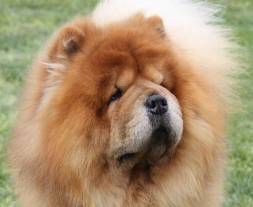 Chow Chow Chow Chow |
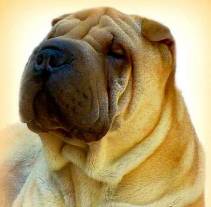 Shar Pei Shar Pei |
|
| Head | The broad skull should be flat with a small amount of stop. The broad muzzle should be moderate in length, but well filled out under the eyes. The wide, large nose should be preferably black. However, cream and white dogs may have a light-coloured nose and blues and fawns may have a self-coloured nose. | The broad, flat relatively large skull should be approximately equal to the muzzle length with a moderate stop in between. There is moderate wrinkle on forehead and cheeks. The broad muzzle should not taper and may also be padded. The large, wide nose should be preferably black. |
| Mouth | The Chow has a normal scissors bite. However, the bluish black tongue coupled with the flews, roof of mouth and gums being black are an important distinguishing feature. | The Shar Pei has a normal scissors bite with excessive padding of lower lip not interfering with the bite. However, the tongue, roof of mouth, gums and flews are preferably solid bluish-black to lavender colour. |
| Eyes | The small eyes should be dark and preferably almond-shaped, although in blue or fawn dog a lighter colour is permissible. A small amount of wrinkle in the skin of the brows over his eyes adds to the 'scowl' typical of his expression. | Although amber and lighter eye colour is permitted, the dark, medium sized, almond shaped gives the frowning expression. But the function of eyeball and lids should not be disturbed by the surrounding skin or folds or hair. |
| Ears | The small, thick ears are slightly rounded at the tip. Set wide apart are carried stiffly erect, they are placed well forward over and the eyes. This adds also to the Chow's the scowl, a unique characteristic of the breed. | The ears are very small, rather thick, equilateral triangular in shape are slightly rounded at tip. They are set high, wide apart and close to the skull with tips pointing towards the eyes. The tips and edges may turn up. |
 Chow (Smooth Coat) Chow (Smooth Coat) |
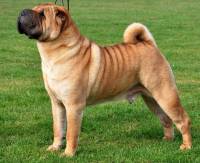 Shar Pei Shar Pei |
|
| Neck | The neck should balance the body | The neck should be of medium length, with some but not excessive dewlap. |
| Forequarters | The shoulders should be muscular and sloping and the perfectly straight forelegs should be of moderate length and have good bone. | The well laid shoulders are muscular with the elbows close to body. The straight forelegs are of moderate length, have good bone and are completely free from wrinkle when mature. |
| Body | The chest in broad and deep, and the back short, straight and strong. The loins are powerful and muscular. | The height at withers approximately equals to the length from point of shoulders to point of buttock. The chest is broad and deep, the back short and the lions broad. Adult dogs should display moderate wrinkling over shoulders and base of tail but excessive skin on body when mature highly undesirable. |
| Hindquarters | The hind legs are muscular but perfectly straight despite the hocks being well let down. This is essential in producing the Chow's characteristic gait. | The hind legs are muscular and strong with no excessive wrinkling or thickening. They are moderately angulated. |
| Feet | Small, round and compact | Moderate sized and compact. |
| Tail | Set high and carried well over the back | Set and carried very high in a tight curl or curved over |
 Chow Chow Chow Chow |
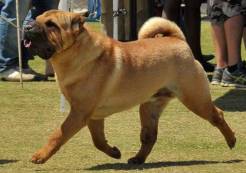 Shar Pei Shar Pei |
|
| Gait | His 'unique stilted gait' means restricted rear movement lacking drive. In other words, his rear legs move in an unnatural pendulum-like straight line, not extending as far forwards or backwards as usual. Without rolling his body, the strength in hind legs thrust his body weight forwards through his short loin to his front legs. | At a trot, the Shar Pei moves with free, vigorous but with balanced reach and drive. But because he has moderate angulation behind, rear single tracking is normal at a fast trot. |
References and Further Reading
[1] V.W.F. Collier, 'Dogs of China and Japan' Published by Frederick Company 1921, Chapter 1V "Sporting and Guard Dogs" Page 58
[1a] Ibid., Chapter 1V Pages 69 - 70 (quoted from White's "Natural History of Selborne" Published 1802 Vol ii Page 77)
[2] C.C.Rotch, Hutchinson's Dog Encyclopedia - Chow Chow, Points Accepted by the Chinese Chow Club Published by Hutchinson & Co. (Publishers) LTD., 34 - 36 Paternoster Row, London, E.C.4 1933 Page 308.
[3] Paul Strang and Eve Olsen - The Chinese Shar-Pei - Published by Denlinger's Publishers, Ltd, USA 22030 ISBN 0-87714-072-3 The Rescue Operation Page 11
[4] 'Tyzack's Annual' Compiled by T. W.Tyzack and C.S.Turner Published by the Victorian Poultry and Kennel Club 1912 by Bellamine Bros. Printers, 66-70 Flinders Lane Melbourne Page 84 Stud Book 17
[5] Phillipa (Betty) Pierce and Elizabeth Simpson 'the Chow Chow' 'The History of Purebred Dogs in Australia' published by OzDog Newspaper 1997 Page 93
[5a] Ibid., Iva Brewis, Shar Pei Page 270
[6] An Illustrated Guide to the Chinese Shar Pei produced by the American Kennel Club Page 5
[7] Edward C Ash 'Dogs their History and Development' Published by Ernest Benn Ltd., 1927. Chapter 11 'The Problem of Domesticated Dogs and its wild Relatives Page 21
[8] The American Kennel Club with permission of the Chinese Shar Pei Club of America 'The Chinese Shar Pei - An Illustrated Guide' Page 5 'History of the Breed'
[9] E.M.Simpson and Phillipa (Betty) Pierce 'History of the The Chow Chow in Australia' Self Published 1995
[10] Material from a Scrap Book supplied by Bob Williams, Chowleigh Kennels